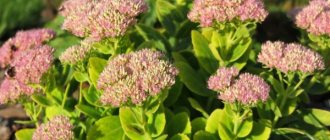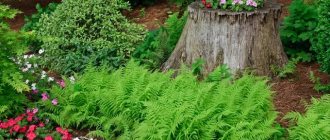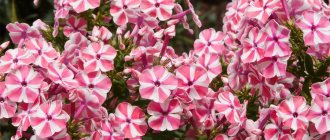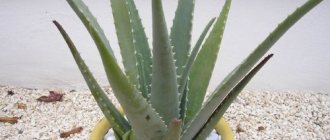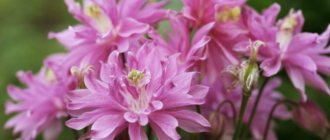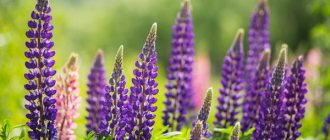An unpretentious perennial succulent of the Crassulaceae family, which will add bright colors to any flower garden or decorate a windowsill, is hare cabbage (sedum). It blooms with small flowers from mid-summer until autumn. Sedum can be ground cover, ampelous or erect.
Hare cabbage - what is it?
This name hides several plants at once. These are common sorrel, mantle, young and sedum. Of these, sedum and common sorrel are used as medicinal herbs in folk medicine. The healing properties of these herbs are used to cleanse blood vessels, to strengthen and improve immunity, normalize metabolic processes, and to treat the digestive system. The sedum flower is not conspicuous; it has a dense inflorescence of small pink flowers.
What does hare cabbage look like?
The main representative of the genus Sedum, or Sedum in Latin, is the large or common sedum. This perennial plant belongs to the Crassula family. Has a short rhizome. The shoots are succulent, not branching, erect. The leaf blades are fleshy, oblong-elliptical in shape, arranged oppositely. The leaves of sedum can have not only the traditional green color, but also bluish, pink, gray and others. As it grows, it forms a lush subshrub up to 90 cm high.
It is interesting to know how hare cabbage blooms: the inflorescences are corymbose-paniculate, dense, located on short stalks. The flowers are star-shaped, small. They can be blue, pink, white, yellow. The flowers emit a strong aroma, which attracts numerous insects. Sedum is a honey-bearing plant. Flowering period from July to October.
Photo gallery
Oxalis leaves reach a length of 2.5 cm and a width of 3 cm. They consist of three separate lobes, which fold lengthwise in a few minutes and droop before inclement weather, at night and due to mechanical irritation.
Oxalis has small flowers located at the ends of thin stems. They consist of white petals with pink-violet veins. Inside the inflorescence there are 2 circles, each of which consists of 5 thin stamens. In the middle there is a pistil, which has 5 long columns with stigmas at the ends and the ovary of future seeds from 5 nests. Blooms from early or mid-May to late July.
The fruits of oxalis are difficult to notice. They are small green balls that are located where flowers used to be. If you touch the fruits of sorrel, they seem to explode and “shoot” seeds. This happens due to the presence of a special “device” on the side of the seeds, which operates on the principle of a repulsive spring.
Sedum species
There are many varieties of sedum, but they can be roughly divided into cold-resistant and heat-loving. The latter are grown indoors, and the group of cold-resistant species is represented by perennial ground cover sedums. Let's look at the main representatives of this plant:
- Linda Windsor
. It has burgundy stems, dark red leaves and ruby flowers. Height 30-40 cm. Blooms relatively late in August-September. The bush holds its shape perfectly and does not fall apart. - Morgana
. The heat-loving succulent in our latitudes is grown indoors as a perennial hanging plant. The leaves look like scales, the shoots themselves hang down. Because of the unusual appearance of its shoots, this plant is called “Monkey or Donkey Tail.” It has a long peduncle with pink-red flowers. - Red-colored
. Stems up to 30 cm long have an unusual color: green at the base and red at the tips. The flowers are bright yellow. - Steel
. This variety is a shrub, reaching a height of 20 cm. It grows well in indoor conditions. The leaves of the plant are reddish-brown with a little down. The flowers are yellow. The leaves fall and take root in the soil.
Sedum is wonderful
This species includes the prominent sedum. It grows in low bushes with straight stems (30–60 cm). The light green leaves are large and slightly toothed. The flowers are dense and large. They have corymbose inflorescences (10–15 cm) with long stamens, pink-purple color.
Sedum grows well in humus-rich fertile soil
The origin of the prominent sedum is Northern China and Korea. Sedum grows well in fertile soil rich in humus. Loves sunny areas very much.
If the sedum feels a lack of sun, it stretches out and stops blooming. It, like the previous species, is classified as winter-hardy. During the winter, the above-ground part of the sedum dies off. This type of sedum differs from others in its late flowering.
You can see photos of prominent sedums in our article.
Planting hare cabbage
Varieties of plants of the sedum genus can be sown by seeds and planted in seedlings, cuttings or dividing the bush. When planting seeds, soil mixed with sand is poured into a container and covered with a layer of coarse sand on top. Next, place the seeds at a distance of 0.4-0.5 cm. Well irrigate the soil along with the seeds from a spray bottle, cover with film and leave on the bottom shelf of the refrigerator for stratification (keeping the seed material for accelerated germination) at a temperature of 0-5°C. Periodically, the crops are opened for ventilation.
After two weeks, the container is placed on the windowsill. The first shoots will appear in 2-3 weeks. All this time, the container with seeds needs to be ventilated, sprayed with water and excess condensation removed. The stratification process can be done by sowing seeds before winter in a container and leaving it in a greenhouse or digging it in the garden. In the spring, such a container is brought home. Planting in open ground and cleaning to a permanent place is carried out when the threat of night frosts disappears.
Soil for sedum
This plant grows well in any soil. As a succulent, bunny cabbage grass prefers soil with good drainage. Poor, sandy soils are suitable for creeping species. Hare cabbage produces tall and profusely blooming flowers on nutritious loamy soils. Particular attention should be paid to soil moisture. Since plants of this genus grow on arid soils, you should not place sedum in lowlands and places where moisture can accumulate and stagnate.
Description of the plant
are about 800 varieties in the world no more than 5 varieties are grown at home
Hare cabbage has leaves of different shapes and colors - green, pink, lilac, green, purple. 2, 3 or 4 leaves depending on the variety. The fruit, which forms after flowering, is a capsule. When the seed shell swells, the capsule cracks and throws them out at a distance of up to 1.5 meters. Because of this, wood sorrel must be controlled, otherwise it will take over the entire garden.
Oxalis reproduces by rhizome, covering new territories. There are some species whose flowers self-pollinate within the forest floor. This is due to early flowering and unstable cold weather in spring.
The foliage folds in half in the evening and opens again in the morning. The same thing happens before a change in weather, for example, before rain. Oxalis reacts the same way.
The most important advantage of hare cabbage is its low maintenance requirements, since the plant is adapted to the conditions of the middle zone.
Interesting! There is also a variety of sedum - a fleshy plant, which is also called hare cabbage
Rabbit cabbage - care
An unpretentious plant that requires no effort when growing. Let's look at the main features of cleaning care:
- Hare cabbage does not like thickening and weeds. Prefers spacious, well-lit places. Sunlight is very important for this plant.
- Watering is necessary only in hot summers and in moderation.
- To create an attractive appearance, old, faded shoots must be cut off.
- Before the start of winter, the sedum should be covered with non-woven material and spruce branches. In frosty winters with little snow, hare cabbage may freeze.
- Once every five years, the bushes need to be divided and replanted in a new place.
Watering sedum
Plants of the Crassulaceae family do not tolerate excessive watering. Moisturizing should occur after the earthen clod has completely dried. Hare cabbage is a plant whose roots begin to rot with frequent watering. As for indoor plants, approximately watering sedum should be done no more than twice a week, and in winter once every 25-30 days, and the soil must dry out. It is better to “under-water” a plant than to over-water it. For indoor plants, after watering, after half an hour, it is necessary to remove the water from the pan. Sedum does not need spraying.
Feeding sedum
Preferring poor, sandy soils, the sedum plant grows well in garden plots without the addition of additional fertilizers. Nutrients can be added to indoor varieties of this plant. A special fertilizer for succulents is suitable for this. It is advisable to fertilize once a month in early spring. From September to March there is a dormant period when there is no need to apply fertilizers.
Pruning sedum
Before winter, you need to prepare hare cabbage and cut the plant, leaving only 3-4 cm above the soil level. Then sprinkle with a layer of soil. Cut shoots can be placed in water and, when roots appear, transplanted into the ground, thereby propagating the plant. Rabbit cabbage flowers need pruning after flowering to maintain an attractive flowering bush. In creeping types of sedum, elongated shoots are pruned, which disrupt the overall decorative appearance.
Problems during cultivation
When growing and caring for sorrel at home, the following problems are possible:
- Growth stops at temperatures above 27 degrees . Additional moisture and spraying will be required.
- Root rotting due to lack of drainage in the pot.
- Lack of water results in lethargy and loss of turgor in the leaves.
- With a lack of light, flowering will be weak and the leaves will be dull.
- Fungal diseases when kept and watered in too cold conditions.
When the fungus spreads on plants, they cannot be saved. It is recommended to throw away the pot and not use it for planting other flowers.
Hare cabbage - reproduction
Getting a hare cabbage flower on your property is not difficult, since there are several ways to propagate this plant. Let's list them:
- Seeds
. This method is painstaking and requires time and effort. Suitable for planting new varieties or breeding. - By cuttings
. This vegetative method is convenient for propagating existing sedum plants. To do this, either before flowering begins or after it ends, shoots about 10 cm long are cut off, the lower leaves are removed and buried in a mixture of sand and soil. After rooting, the plant is transplanted to a permanent place. - Dividing the bush
. Propagation by dividing sedum can be done in early spring by digging up the entire plant, clearing it of soil and dividing it into several parts. Then treat the sections with a fungicide and put them in a cool place to dry for several hours. Then they are planted in a permanent place.
Medicinal properties
- Stimulates the heart. Used as a means to increase the tone of the heart muscle.
- Quickly removes excess fluid from the body.
- Sedum compresses are used after injuries of any severity as a powerful hemostatic and healing drug.
- Sedum is an excellent tonic that is used for fatigue and nervous disorders.
- Preparations based on this plant strengthen the body's natural defenses. Sedum is a powerful immunostimulant, which in its biological activity is on a par with hemlock and aloe.
- The plant has a beneficial effect on the functioning of the liver and kidneys.
- Preparations based on sedum are used during the treatment of respiratory diseases (asthma, pneumonia, tuberculosis, bronchitis, tracheitis) as an anti-inflammatory agent.
- The plant is indicated for gynecological diseases (uterine fibroids, cysts). In addition, drugs based on it help normalize the menstrual cycle.
Replanting sedum
It is not advisable for sedum to grow in one place for more than five years. It is necessary to replant the plant to a new location. This can be done by cutting off old shoots and digging up the entire bush. Then prepare a hole in a new place by first pouring sand and wood ash into it and place the plant, covering it with a layer of earth. Transplantation is carried out in early spring. Indoor sedum plants need to be replanted very carefully, since the leaves may break off when touched, and the hare cabbage will lose its attractive appearance.
Diseases and pests rejuvenated
The main enemy of the young ones is birds, namely: magpies, jays, jackdaws and crows.
The larvae of the cockchafer can also damage the juveniles; they gnaw not only the roots, which the juveniles could easily deal with, but they also manage to eat away the base of the succulent shortened stem. Such rosettes have to be re-rooted, having first picked off that part of the leaves that was left without “support”. In those places where the soil is heavily infested with this pest, it is useful to replant the juveniles annually, selecting the larvae from the ground.
Of the diseases, rot of an undetected nature often causes trouble. In rainy, cold weather, individual sockets rot. At first they become as if transparent, and quickly turn brown and “deoxidize.” But, as a rule, the process does not spread to neighboring sockets. The diseased ones simply need to be removed early, and it is clear that the rotting process begins from below.
Hare cabbage in landscape design
The species diversity of the hare cabbage plant includes more than half a thousand varieties. Every gardener will find a plant to their liking, and thanks to its heat resistance, frost resistance and ease of care, sedum takes pride of place in any garden. Hare cabbage in landscape design is used for planting in rockeries, rock gardens and mixborders. The main varieties used are "Matrona", "Purple Emperor" and "Autumn Joy".
- Burgundy species go well with bright greens.
- Bright bushes can decorate garden paths.
- Green compositions with beautiful pink splashes.
- A beautiful stream can be formed from fresh flowers.
Varieties
Known varieties of purple sedum:
- Purple Emperor is a hardy and winter-hardy variety.
- Black Jack (black jack) is a plant with a height similar to the variety described above, leaves with a bluish tint.
- Strawberries and Cream (Sedum hybrid Strawberries and Cream) is a hybrid that is represented by plants with green leaves and reddish buds, when they open, they become creamy.
- The purple carpet is a very elegant variety.
- Picolette - red-bronze leaves.
Some varieties in the photo:
purple emperor
black Jack
Strawberries and Cream
Contraindications for use
Currently, the properties of the plant have been well studied in medicine and no serious contraindications have been identified, but they still exist.
Particular attention is paid to only one type of plant - Caustic Sedum . Since it is poisonous and its use for treatment purposes should be carried out strictly under the supervision of an experienced specialist. If the rules of administration are not followed, vomiting, dizziness, and respiratory arrest may occur.
This type is strictly prohibited for use by children, pregnant women and people with hypertension.
At your home
Morgana sedum (sedum) has very characteristic features. Ampel-shaped, fleshy leaves densely dotted with the stem. Sedum shoots can reach a length of up to 60 cm, sometimes reaching a meter. They look very beautiful and rich in hanging pots.
This type of sedum loves bright places. Therefore, it should not be allowed to be located on northern windows. Moderate watering is needed.
Sedum loves bright places
Propagated by cuttings, fallen leaves take root easily. Large dishes are not needed when planting sedum, since its root system is poorly developed. The preferred soil for succulents is the addition of red brick crushed into sand.
